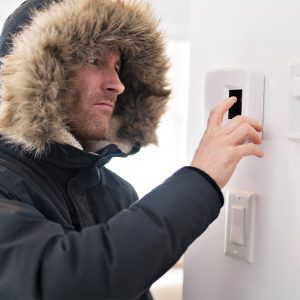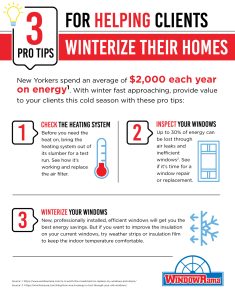
November 10, 2022 by WindowRama
3 Pro Tips for Helping Clients Winterize Their Homes
Helping homeowners protect their home and get through another brutal Northeastern winter is an excellent way to connect with potential customers. These winterization tips may or may not result in a project this season, but every positive and helpful connection you can make builds credibility and trust. When they’re ready to start a project, they’re more likely to start with you.
3 Tips for Home Winterization & Energy Savings
Share these tips with your customers now, before the temperature plummets. It’s easier, more practical, and more affordable to start the winterization process before the mercury drops and the skies dump snow and ice.
1. Check the Heating Systems
Before they need the heat, it’s a good idea to bring the heating system out of its slumber for a test run. Discovering it doesn’t work the first cold day could result in several cold days before a technician can get out to fix it.
If they have a furnace, they should replace the filter, and turn on the heat for just 10-15 minutes to check the thermostat to ensure it’s working. If not, this is the time to schedule a repair.
If they have hot water radiator heat, those need to be turned on and heated up, just for a 10-minute test. If they use heating oil, this is the time to fill the tank. Prices go up when the temperatures go down.
For safety, remind them to check carbon monoxide detectors and smoke alarm batteries. Everything should start with fresh or freshly recharged batteries for winter.
2. Winterize, Repair or Replace Windows
Even with a highly efficient heating system, the windows are where heat can easily escape. If the home is older, chances are, the windows are not as good as they could be to prevent heat loss, and some may even be letting cold air in.
People who have windows they rarely or never open would be surprised to discover that they now won’t open, or the seals are broken. Windows actually perform better with use, so for the life of the window, and to air out the house, suggest that in mild weather, they open the windows for a while.
Offer to check the exterior of the windows. In our climate, the north side of the home holds more moisture, as does any part covered with shrubbery. Dark spots are signs that moisture is festering, causing damage. This means the sealant has failed and will need resealing.
If the windows are not in bad shape but not great at insulating, there are several reasonably simple and cheap DIY home winterization options, available at any hardware store. You can suggest weather strips, plastic window insulation kits, or even storm windows. All these things help insulate the windows, but not as well as having new windows that are better designed for insulation.
Installing replacement windows, while a bigger investment of time and money, is the most effective and longest-lasting solution. The right windows, properly installed, will not need winterizing. They’ll only need the annual maintenance any window would need—less if they’re aluminum or vinyl. Replacement windows also add value to the home.
An efficient heating system with energy-efficient windows will work better together to lower energy bills.
3. Have an Energy Saving Plan

Homeowners are often shocked by how high their energy bills are, even when they’ve invested in more efficient heating systems and energy-saving windows. It’s often the inadvertent habits of the people living in the home that drive up the heating bill.
The biggest and most obvious culprit is the thermostat setting. Some people set it and forget it, letting it run 24/7 at the same temp. Others have thermostat wars with family members, each raising or lowering it to a person’s own personal comfort. Both scenarios keep costs high.
If they really want to lower energy bills, the whole family or whomever is occupying the home, should have a plan and work together to lower costs. That money could be better spent elsewhere!
Here are ways from the thermostat and beyond to keep heating costs down:
- When feeling chilly, put on an extra layer instead of cranking up the heat.
- Turn the heat down when no one is home.
- After boiling water for cooking, leave the pot lid off to let the heat and moisture out into the room.
- Turn the heat down at night while sleeping.
- Don’t have conversations with a visitor through an open front door. Step outside or let them in. An open door invites winter in.
At WindowRama, we’re always happy to help our trade partners work with customers to help solve their energy efficiency issues with better windows and doors. We have 20+ showrooms in the tri-state area that showcase top brands including Andersen. Let your project be our passion.


